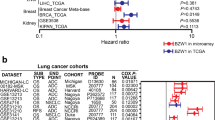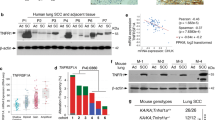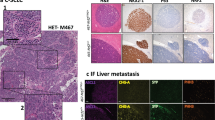Abstract
The C-CRK gene, cellular homolog of the avian v-crk oncogene, encodes two alternatively spliced adaptor signaling proteins, CRKI (28 kDa) and CRKII (40 kDa). Both CRKI and CRKII have been shown to activate kinase signaling and anchorage-independent growth in vitro and CRKI transformed cells readily form tumors in nude mice. Affymetrix oligonucleotide arrays were used to analyse 86 lung adenocarcinomas and 10 uninvolved lung tissues. C-CRK mRNA expression was increased in more advanced (stage III versus stage I), larger (T2–4 versus T1), and poorly differentiated tumors and in tumors from patients demonstrating poor survival (P=0.00034). An overlapping series of 93 lung adenocarcinomas (64 stage I and 29 stage III) and 10 uninvolved lung specimens were measured for quantitative differences in CRKI and CRKII protein levels using 2-D PAGE. CRK protein spots were identified using mass spectrometry and 2-D Western blotting. A significant increase in levels of the CRKI oncoprotein and the phosphorylated isoform of CRKII was observed in tumors (P<0.05). No difference in protein level was evident between stages. Concordant with mRNA expression, CRKI and CRKII were increased in poorly differentiated tumors (P<0.05). CRK immunohistochemical analysis of tumor tissue arrays using the same tumor series also demonstrated increased abundance of nuclear and cytoplasmic CRK in more proliferative tumors (P<0.05). This study provides the first quantitative analysis of discrete CRKI and CRKII protein isoforms in human lung tumors and provides evidence that the C-CRK proto-oncogene may foment a more aggressive phenotype in lung cancers.
This is a preview of subscription content, access via your institution
Access options
Subscribe to this journal
Receive 50 print issues and online access
$259.00 per year
only $5.18 per issue
Buy this article
- Purchase on Springer Link
- Instant access to full article PDF
Prices may be subject to local taxes which are calculated during checkout





Similar content being viewed by others
References
Beer DG, Kardia SLR, Huang C-C, Giordano TJ, Levin AM, Misek DE, Lin L, Chen G, Gharib TG, Thomas DG, Lizyness ML, Kuick R, Hayasaka S, Taylor JMG, Iannettoni MD, Orringer MB and Hanash S . (2002). Nat. Med., 8, 816–824.
Beitner-Johnson D and LeRoith D . (1995). J. Biol. Chem., 270, 5187–5190.
Chen G, Gharib TG, Huang C-C, Thomas DG, Shedden KA, Taylor JMG, Kardia SLR, Misek DE, Giordano TJ, Iannettoni MD, Orringer MB, Hanash SM and Beer DG . (2002). Clin. Cancer Res., 8, 2298–2305.
Cheresh DA, Leng J and Klemke RL . (1999). J. Cell Biol., 146, 1107–1116.
Cho SY and Klemke RL . (2000). J. Cell Biol., 149, 223–236.
Ciruna B and Rossant J . (2001). Dev. Cell, 1, 37–49.
Colby TV, Koss MN and Travis WD . (1995). AFIP Atlas of Tumor Pathology: Tumors of the Lower Respiratory Tract. Washington, DC.
Dolfi F, Garcia-Guzman M, Ojaniemi M, Nakamura H, Matsuda M and Vuori K . (1998). Proc. Natl. Acad. Sci. USA, 95, 15394–15399.
Edelman GM, Gallin WJ, Delouvee A, Cunningham BA and Thiery JP . (1983). Proc. Natl. Acad. Sci. USA, 80, 4384–4388.
Fajardo JE, Birge RB and Hanafusa H . (1993). Mol. Cell. Biol., 13, 7295–7302.
Feller SM . (2001). Oncogene, 20, 6348–6371.
Frixen UH, Behrens J, Sachs M, Eberle G, Voss B, Warda A, Lochner D and Birchmeier W . (1991). J. Cell Biol., 113, 173–185.
Fry WA, Phillips JL and Menck HR . (1999). Cancer, 86, 1867–1870.
Gharib TG, Chen G, Wang H, Huang C-C, Prescott MS, Shedden K, Misek DE, Thomas DG, Giordano TJ, Taylor JMG, Kardia S, Yee J, Orringer MB, Hanash S and Beer DG . (2002). Neoplasia, 4, 440–448.
Giordano TJ, Shedden KA, Schwartz DR, Kuick R, Taylor JMG, Lee N, Misek DE, Greenson JK, Kardia SLR, Beer DG, Rennert G, Cho KR, Gruber SB and Hanash S . (2001). Am. J. Pathol., 159, 1231–1238.
Girardin SE and Yaniv M . (2001). EMBO J., 20, 3437–3446.
Hoffman PC, Mauer AM and Vokes EE . (2000). Lancet, 355, 479–485.
Hughes SJ, Nambu Y, Soldes OS, Hamstra D, Rehemtulla A, Iannettoni MD, Orringer MB and Beer DG . (1997). Cancer Res., 57, 5571–5578.
Klemke RL, Leng J, Molander R, Brooks PC, Vuori K and Cheresh D . (1998). J. Cell Biol., 140, 961–972.
Kononen J, Bubendorf L, Kallioniemi A, Barlund M, Schraml P, Leighton S, Torhorst J, Mihatsch MJ, Sauter G and Kallioniemi OP . (1998). Nat. Med., 4, 844–847.
Kuick RD, Hanash SM, Chu EHY and Strahler JR . (1987). Electrophoresis, 8, 199–204.
Kuick RD, Skolnick MM, Hanash SM and Neel JV . (1991). Electrophoresis, 12, 736–746.
Lamorte L, Royal I, Naujokas M and Park M . (2002). Mol. Biol. Cell, 13, 1449–1461.
Landis SK, Murray T, Bolden S and Wingo PA . (1999). CA Cancer J. Clin., 49, 8–31.
Matsuda M, Tanaka S, Nagata S, Kojima A, Kurata T and Shibuya M . (1992). Mol. Cell. Biol., 12, 3482–3489.
Mayer BJ, Hamguchi M and Hanafusa H . (1988). Nature, 332, 272–275.
Mayer BJ, Hamaguchi M and Hanafusa H . (1989). Cold Spring Harbor Symp. Quant. Biol., 53, 907–914.
Miller JR and McClay DR . (1997). Dev. Biol., 192, 310–322.
Morali OG, Jouneau A, McLaughlin KJ, Thiery JP and Larue L . (2000). Dev. Biol., 227, 133–145.
Naruke T, Goya T, Tsuchiya R and Suemasu K . (1988). J. Thorac. Surg., 96, 440–447.
Nishihara H, Tanaka S, Tsuda M, Oikawa S, Maeda M, Shimizu M, Shinomiya H, Tanigami A, Sawa H and Nagashima K . (2002). Cancer Lett., 180, 55–61.
Oehrl W, Kardinal C, Ruf S, Aderman K, Groffen J, Feng G-S, Blenis J, Tan T-H and Feller SM . (1998). Oncogene, 17, 1893–1901.
Petit V, Boyer B, Lentz D, Turner CE, Thiery JP and Valles AM . (2000). J. Cell Biol., 148, 957–970.
Tanaka S, Ouchi T and Hanafusa H . (1997). Proc. Natl. Acad. Sci. USA, 94, 2356–2361.
Thiery JP . (2002). Nat. Rev. Cancer, 2, 442–454.
Williams DE, Piarolero PC, Davis CS, Bernatz PE, Payne WS, Taylor WF, Uhlenhopp MA and Fontana RS . (1981). J. Thorac. Cardiovasc. Surg., 82, 70–76.
York RD, Yao H, Dillon T, Ellig CL, Eckert SP, McCleskey EW and Stork PJS . (1998). Nature, 392, 622–626.
Acknowledgements
We thank Chiang-Ching Huang, Kerby A Shedden, Jeremy MG Taylor, and Sharon LR Kardia for their helpful discussions. This work was supported by NCI Grant U19 CA-85953.
Author information
Authors and Affiliations
Corresponding author
Rights and permissions
About this article
Cite this article
Miller, C., Chen, G., Gharib, T. et al. Increased C-CRK proto-oncogene expression is associated with an aggressive phenotype in lung adenocarcinomas. Oncogene 22, 7950–7957 (2003). https://doi.org/10.1038/sj.onc.1206529
Received:
Revised:
Accepted:
Published:
Issue Date:
DOI: https://doi.org/10.1038/sj.onc.1206529
Keywords
This article is cited by
-
Gab2 plays a carcinogenic role in ovarian cancer by regulating CrkII
Journal of Ovarian Research (2023)
-
IFNs-signaling effects on lung cancer: an up-to-date pathways-specific review
Clinical and Experimental Medicine (2017)
-
Cyclophilin A promotes cell migration via the Abl-Crk signaling pathway
Nature Chemical Biology (2016)
-
The adaptor protein CrkII regulates IGF-1-induced biological behaviors of pancreatic ductal adenocarcinoma
Tumor Biology (2016)
-
Phosphorylation of Dok1 by Abl family kinases inhibits CrkI transforming activity
Oncogene (2015)



